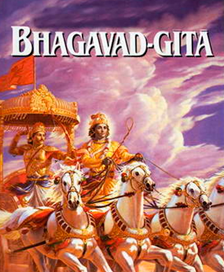The Bhagavad Gita

The Bhagavad Gita
Introduced & Translated by Eknath Easwaran
Chapter Introductions by Diane Morrison
On this path effort never goes to waste, and there is no
failure. Even a little effort toward spiritual awareness will protect you from the greatest fear.
[2:40]
Contents
Foreword
Introduction
Chapter One, The War Within
Chapter Two, Self-Realization
Chapter Three, Selfless Service
Chapter Four, Wisdom in Action
Chapter Five, Renounce & Rejoice
Chapter Six, The Practice of Meditation
Chapter Seven, Wisdom from Realization
Chapter Eight, The Eternal Godhead
Chapter Nine, The Royal Path
Chapter Ten, Divine Splendor
Chapter Eleven, The Cosmic Vision
Chapter Twelve, The Way of Love
Chapter Thirteen, The Field & the Knower
Chapter Fourteen, The Forces of Evolution
Chapter Fifteen, The Supreme Self
Chapter Sixteen, Two Paths
Chapter Seventeen, The Power of Faith
Chapter Eighteen, Freedom & Renunciation
Notes
Glossary
Index
Foreword
The Classics of Indian Spirituality
Imagine a vast hall in Anglo-Saxon England, not long after the passing of King Arthur. It is the dead of winter and a fierce snowstorm rages outside, but a great fire fills the space within the hall with warmth and light. Now and then, a sparrow darts in for refuge from the weather. It appears as if from nowhere, flits about joyfully in the light, and then disappears again, and where it comes from and where it goes next in that stormy darkness, we do not know.
Our lives are like that, suggests an old story in Bede’s medieval history of England. We spend our days in the familiar world of our five senses, but what lies beyond that, if anything, we have no idea. Those sparrows are hints of something more outside – a vast world, perhaps, waiting to be explored. But most of us are happy to stay where we are. We may even be a bit afraid to venture into the unknown. What would be the point, we ask.
Why should we leave the world we know?
Yet there are always a few who are not content to spend their lives indoors. Simply knowing there is something unknown beyond their reach makes them acutely restless. They have to see what lies outside – if only, as George Mallory said of Everest, “because it’s there.”
This is true of adventurers of every kind, but especially of those who seek to explore not mountains or jungles but consciousness itself: whose real drive, we might say, is not so much to know the unknown as to know the knower. Such men and women can be found in every age and every culture. While the rest of us stay put, they quietly slip out to see what lies beyond.
Then, so far as we can tell, they disappear. We have no idea where they have gone; we can’t even imagine. But every now and then, like friends who have run off to some exotic land, they send back reports: breathless messages describing fantastic adventures, rambling letters about a world beyond ordinary experience, urgent telegrams begging us to come and see. “Look at this view! Isn’t it breathtaking? Wish you could see this. Wish you were here.”
The works in this set of translations – the Upanishads, the Bhagavad Gita, and the Dhammapada – are among the earliest and most universal of messages like these, sent to inform us that there is more to life than the everyday experience of our senses. The Upanishads are the oldest, so varied that we feel some unknown collectors must have tossed into a jumble all the photos, postcards, and letters from this world that they could find, without any regard for source or circumstance. Thrown together like this, they form a kind of ecstatic slide show – snapshots of towering peaks of consciousness taken at various times by different observers and dispatched with just the barest kind of explanation. But those who have traveled those heights will recognize the views: “Oh, yes, that’s Everest from the northwest – must be late spring. And here we’re south, in the full snows of winter.”
The Dhammapada, too, is a collection – traditionally, sayings of the Buddha, one of the very greatest of these explorers of consciousness. In this case the messages have been sorted, but not by a scheme that makes sense to us today. Instead of being grouped by theme or topic, they are gathered according to some dominant characteristic like a symbol or metaphor – flowers, birds, a river, the sky – that makes them easy to commit to memory. If the Upanishads are like slides, the Dhammapada seems more like a field guide. This is lore picked up by someone who knows every step of the way through these strange lands. He can’t take us there, he explains, but he can show us the way: tell us what to look for, warn about missteps, advise us about detours, tell us what to avoid. Most important, he urges us that it is our destiny as human beings to make this journey ourselves.
Everything else is secondary.
And the third of these classics, the Bhagavad Gita, gives us a map and guidebook. It gives a systematic overview of the territory, shows various approaches to the summit with their benefits and pitfalls, offers recommendations, tells us what to pack and what to leave behind. More than either of the others, it gives the sense of a personal guide. It asks and answers the questions that you or I might ask – questions not about philosophy or mysticism, but about how to live effectively in a world of challenge and change. Of these three, it is the Gita that has been my own personal guidebook, just as it was Mahatma Gandhi’s.
These three texts are very personal records of a landscape that is both real and universal. Their voices, passionately human, speak directly to you and me. They describe the topography of consciousness itself, which belongs as much to us today as to these largely anonymous seers thousands of years ago. If the landscape seems dark in the light of sense perception, they tell us, it has an illumination of its own, and once our eyes adjust we can see in what Western mystics call this “divine dark” and verify their descriptions for ourselves.
And this world, they insist, is where we belong. This wider field of consciousness is our native land. We are not cabin-dwellers, born to a life cramped and confined; we are meant to explore, to seek, to push the limits of our potential as human beings. The world of the senses is just a base camp: we are meant to be as much at home in consciousness as in the world of physical reality.
This is a message that thrills men and women in every age and culture. It is for such kindred spirits that these texts were originally composed, and it is for them in our own time that I undertook these translations, in the conviction that they deserve an audience today as much as ever. If these books speak to even a handful of such readers, they will have served their purpose.
Introduction
The Bhagavad Gita
Many years ago, when I was still a graduate student, I traveled by train from central India to Simla, then the summer seat of the British government in India. We had not been long out of Delhi when suddenly a chattering of voices disturbed my reverie. I asked the man next to me if something had happened. “Kurukshetra!” he replied. “The next stop is Kurukshetra!”
I could understand the excitement. Kurukshetra, “the field of the Kurus,” is the setting for the climactic battle of the Mahabharata, the vastest epic in any world literature, on which virtually every Hindu child in India is raised. Its characters, removed in time by some three thousand years, are as familiar to us as our relatives. The temper of the story is utterly contemporary; I can imagine it unfolding in the nuclear age as easily as in the dawn of Indian history. The Mahabharata is literature at its greatest – in fact, it has been called a literature in itself, comparable in its breadth and depth and characterization to the whole of Greek literature or Shakespeare. But what makes it unique is that embedded in this literary masterpiece is one of the finest mystical documents the world has seen: the Bhagavad Gita.
I must have heard the Gita recited thousands of times when I was growing up, but I don’t suppose it had any special significance for me then. Not until I went to college and met Mahatma Gandhi did I begin to understand why nothing in the long, rich stretch of Indian culture has had a wider appeal, not only within India but outside as well. Today, after more than thirty years of devoted study, I would not hesitate to call it India’s most important gift to the world. The Gita has been translated into every major language and perhaps a hundred times into English alone; commentaries on it are said to be more numerous than on any other scripture. Like the Sermon on the Mount, it has an immediacy that sweeps away time, place, and circumstance. Addressed to everyone, of whatever background or status, the Gita distills the loftiest truths of India’s ancient wisdom into simple, memorable poetry that haunts the mind and informs the affairs of everyday life.
Everyone in our car got down from the train to wander for a few minutes on the now peaceful field. Thousands of years ago this was Armageddon. The air rang with the conch-horns and shouts of battle for eighteen days. Great phalanxes shaped like eagles and fish and the crescent moon surged back and forth in search of victory, until in the end almost every warrior in the land lay slain.
“Imagine!” my companion said to me in
